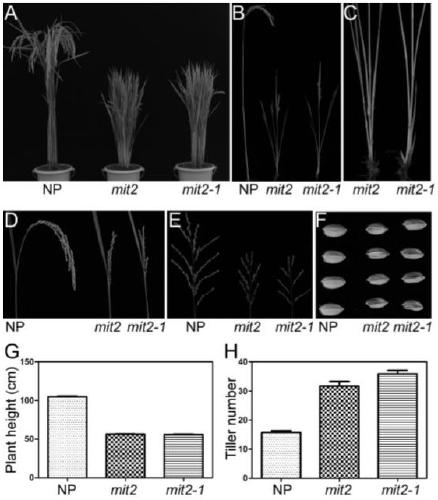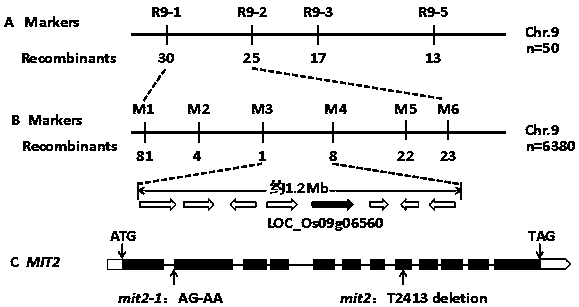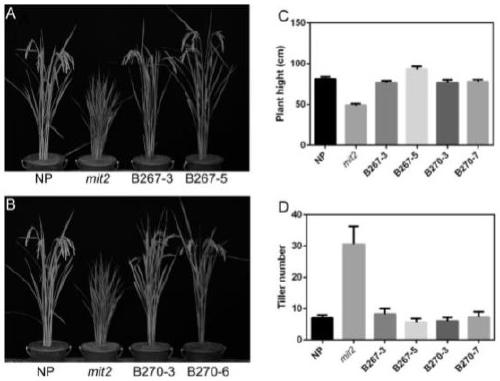Rice MIT2 gene and protein encoded by same, and application thereof
A rice and protein technology, applied in the field of genetic engineering, can solve the problems such as the reduction of tiller number and the loss of OsTB1 function, and achieve the effect of obvious screening effect, huge economic value and improving rice productivity.
- Summary
- Abstract
- Description
- Claims
- Application Information
AI Technical Summary
Problems solved by technology
Method used
Image
Examples
Embodiment 1
[0049] Example 1 Obtaining and Phenotype Analysis of Mutants
[0050] A japonica rice variety Nipponbare was chemically induced by EMS to obtain a mutant with moderately increased tillers Moderately Increased Tiller-2 ( mit2 ) and its allelic mutants mit2-1 . mit2 Mutations to base deletions, allelic mutants mit2-1 It has a similar dwarf multi-tiller phenotype, and the mutation is a base substitution.
[0051] Phenotypic analysis showed that the mutant had many changes compared with the wild type ( figure 1 ). rice mit2 The plant height of the mutant is shorter than that of the wild type, and the plant height at the mature stage is slightly shorter, about 60% of the wild type, and the internodes are shortened to a certain extent; mit2 The mutant had a moderate increase in tillering, which was about twice that of the wild type. mutant mit2 and its allelic mutants had fewer branches, lower fertility, smaller grains, and open glumes.
Embodiment 2
[0052] Example 2 Rice MIT2 Gene acquisition and functional complementation verification
[0053] 1. Rice MIT2 Gene acquisition
[0054] of the present invention MIT2 mutant mit2 cloned. homozygous mutant mit2 When crossed with Dular, an indica rice variety with normal phenotype and high polymorphism, all crosses F 1 The medium individuals showed normal plant height and tiller number. f 2 Obtain segregating populations for genetic analysis and gene mapping. The analysis of the lines with segregated traits in the F2 generation showed that the segregation ratio of the wild type and the mutant conformed to the 3:1 genetic segregation ratio, which indicated that the mutant trait was controlled by a pair of recessive genes.
[0055] In order to locate the position of the gene controlling the moderately increased tillering mutant, we used the F 2 The segregated population was used as the targeted population, and 10 strains of F 2 A DNA pool was constructed from a mutan...
Embodiment 3
[0063] Example 3 Rice MIT2 gene expression pattern
[0064] to be clear MIT2 The tissue expression pattern of the gene is to extract the RNA of different tissues (seeds, roots, stems, leaves, leaf sheaths, young spikes, flowers, tiller buds, seedlings, and young roots) of the japonica rice variety Nipponbare, reverse transcribe into cDNA, and use the rice Ubiquitin gene as As an internal reference, Real-time PCR was used to detect the expression level of the gene in various tissues of rice, and the results showed that MIT2 The gene is expressed in the above tissues of rice, with the highest expression level in young roots, followed by higher expression levels in young panicle seeds and seedlings, and also expression levels in leaf sheaths and tiller buds, and relatively lower levels in seeds and mature roots ( Figure 4 ).
PUM
 Login to View More
Login to View More Abstract
Description
Claims
Application Information
 Login to View More
Login to View More - R&D
- Intellectual Property
- Life Sciences
- Materials
- Tech Scout
- Unparalleled Data Quality
- Higher Quality Content
- 60% Fewer Hallucinations
Browse by: Latest US Patents, China's latest patents, Technical Efficacy Thesaurus, Application Domain, Technology Topic, Popular Technical Reports.
© 2025 PatSnap. All rights reserved.Legal|Privacy policy|Modern Slavery Act Transparency Statement|Sitemap|About US| Contact US: help@patsnap.com



